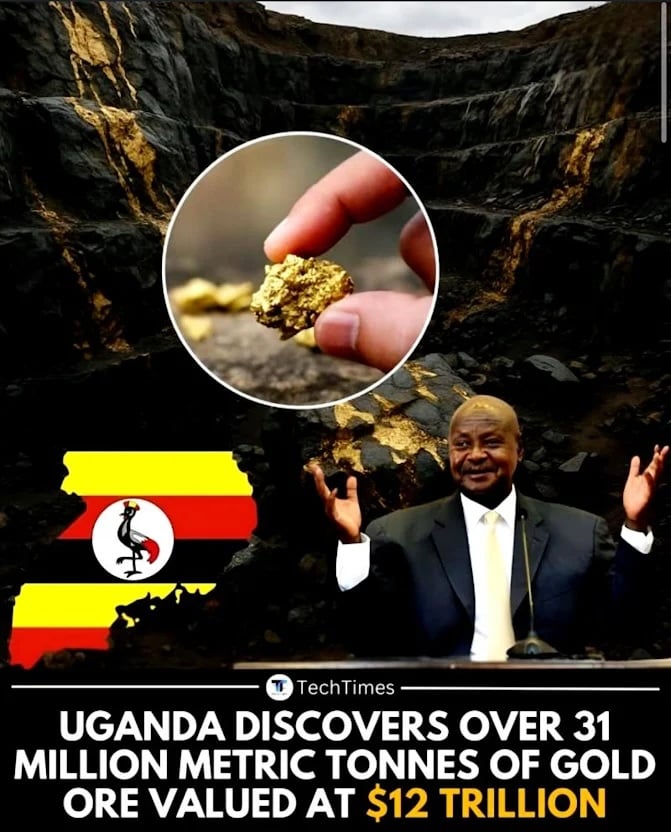(Mike Maharrey, Money Metals News Service) Over the last several weeks, I’ve seen several stories about a massive gold discovery in Uganda.
According to the reports, exploration surveys indicate a deposit of 31 million tonnes of ore that would yield approximately 320,158 tonnes of refined gold, valued at $12 trillion.

To put that into perspective, according to the World Gold Council, about 216,265 tonnes of gold have been mined throughout history.
In other words, the Ugandan government claims it has discovered gold reserves that are 56 percent larger than the total amount of gold mined — ever.
If this seems a little suspicious, that’s because it is.
I’m not sure why this story is suddenly making the rounds again. The initial report came out in 2022.
At the time, Reuters reported that an official with the Ugandan Ministry of Energy and Development reported the discovery.
Quite frankly, it just doesn’t add up. I intuitively recognized this, and so did Luke Burgess. He ran the numbers and published an article on OutsiderClub.com.
Given the amount of refined gold the Ugandans claimed they could produce from the ore, the average gold grade would be more than 10,000 grams per tonne (g/t).
According to Burgess, the highest graded gold mine at the time was Agnico Eagle’s Fosterville mine in Australia. Before the pandemic, the average grade was around 40 g/t. During the first quarter of 2022, it had dropped to 28 g/t. Even then, it was still the highest graded mine.
Burgess summed it up.
“So, the absolute highest-grade gold mine in the world right now is operating with an average head grade of under 30 g/t. And the Ugandan government is saying its country has a massive ore resource with an average grade over 10,000 g/t.
“Unbelievable!”
Yes. Yes, it is.
Burgess said that if there was such a discovery, “there would be visible gold absolutely everywhere. Gold would be spilling out of the rock. You wouldn’t be able to walk without stepping on gold.”
So, why would the Ugandan government fabricate such a story?
Maybe there was just a mistake in the reporting. Perhaps they meant 320,158 ounces of gold. That would make more sense.
Or maybe something else is going on.
The answer may well lie in the very first sentence of that Reuters report.
“It [the Ugandan government] wants to attract big investors to develop the sector hitherto dominated by small wildcat miners.”
And guess what? I ran across this article on mining-technology.com reporting on the opening of Uganda’s first large-scale gold mining. Buried in the article was this tidbit.
“Furthermore, a new mining law enacted in 2022 allows the Ugandan Government to take a mandatory 15 percent free carry stake in all mining operations within the country.”
What year was this immense Ugandan gold discovery?
Oh, yeah. 2022.
Now, I’m not saying the Ugandan government lied to incentivize big miners to come into the country – but I’m not saying they didn’t either.
This raises another question. Why does a story that seems sketchy when given the slightest bit of thought keep getting traction out there in the social media world?
It could be that people are drawn to fantastic stories – and a $12 trillion gold deposit is certainly fantastic.
But there could be more to it.
I’m speculating here, but it could be that people who would prefer you not be so bullish on gold keep recycling this tale. I’m talking about Bitcoin pumpers or government actors who want you to believe gold isn’t all that valuable. After all, if we have this massive discovery, gold isn’t quite as scarce as we thought, and therefore less valuable.
In fact, other stories along the same line seem to get a lot of play. For instance, the fact that there is apparently an asteroid containing trillions of dollars of gold floating out there in space. Never mind that there is no way to mine the gold; the story is often used to point out that gold is more abundant than we realize.
But it isn’t.
And then there was the recent headline declaring that scientists have turned lead into gold. Of course, according to researchers’ calculations, it would take about 33.9 billion years to create one ounce of gold at the rate they can create it.
Yes, there is a lot of gold in the universe. Heck, there is a lot of gold on Earth. But we can’t get to it. And if we can’t get to it, it may as well not exist.
Don’t let these stories fool you. Gold is scarce. Gold is valuable. And you want some gold. You know you do!
Mike Maharrey is a journalist and market analyst for Money Metals with over a decade of experience in precious metals. He holds a BS in accounting from the University of Kentucky and a BA in journalism from the University of South Florida.

